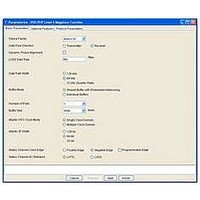IP-POSPHY4 Altera, IP-POSPHY4 Datasheet - Page 125

IP-POSPHY4
Manufacturer Part Number
IP-POSPHY4
Description
IP CORE - POS-PHY Level 4 SPI 4.2 Interface
Manufacturer
Altera
Type
MegaCorer
Datasheet
1.IP-POSPHY4.pdf
(144 pages)
Specifications of IP-POSPHY4
Software Application
IP CORE, Interface And Protocols, COMMUNICATION
Supported Families
Arria GX, Cyclone, HardCopy, Stratix
Core Architecture
FPGA
Core Sub-architecture
Arria, Cyclone, Stratix
Rohs Compliant
NA
Function
POS-PHY Level 4 Interface, Link-Layer/PHY Layer
License
Initial License
Lead Free Status / RoHS Status
na
Lead Free Status / RoHS Status
na
- Current page: 125 of 144
- Download datasheet (3Mb)
Introduction
Programming the SPI-4.2 Calendar
December 2010 Altera Corporation
f
1
An Avalon
PHY Level 4 MegaCore
parameters, provided the required features have been turned on in IP Toolbench.
Specifically, if the Asymmetrical Port Support is turned on, the Avalon-MM interface
allows you to program the SPI-4.2 calendar. It also allows you to control the associated
Hitless B/W reprovisioning feature, provided that option is turned on. You can
thereby allocate more bandwidth to a certain port by repeating it any number of times
in the calendar sequence.
The Asymmetrical Port Support allows the SPI-4.2 status channel to have a calendar
length of up to 1,024 slots, where each slot can be associated with any valid port-
address number. The range of valid port numbers is zero to the number of ports - 1.
You can set the maximum calendar length and number of ports for your variation of
the POS-PHY Level 4 MegaCore function using IP Toolbench within the Quartus II
software (refer to
This approach requires that the receiver and transmitter MegaCore functions
maintain identical tables that map each calendar slot number to a port address
number. When the hitless bandwidth reprovisioning feature is turned on, two
calendars are supported thereby requiring two tables. Internally, the POS-PHY Level 4
MegaCore function stores the mappings in a memory which must be configured after
reset. Access to the table memory is provided via the Avalon-MM register fields:
CALMEM_ADR, CALMEM_DAT0, and CALMEM_DAT1.
For details, refer to the
“Avalon-MM Interface Register Map” on page
This section provides a step-by-step example, using a 4-port receiver variation with
hitless bandwidth reprovisioning, and the following calendar length and port address
number values:
■
■
To program the calendar, follow these steps:
These instructions assume that you are familiar with the Avalon-MM interface and the
Avalon Interface
guide.
1. Disable the status channel by writing a 1 to the RSFRM bit.
Calendar 0 (CAL0) has 5 slots, and port 3 is allocated two calendar slots. The
desired calendar sequence may be: 0,3,2,3,1.
Calendar 1 (CAL1) has 3 slots, and only 3 ports are enabled. The desired calendar
sequence may be: 1,2,3.
®
Memory-Mapped (Avalon-MM) interface is included with some POS-
Specifications, and that you have read the previous chapters of this user
Chapter 2, Getting Started
E. Programming the SPI-4.2 Calendar via
“Avalon-MM Interface Register Map” on page
®
function variations for easy configurability of some
the Avalon Memory-Mapped Interface
for detailed instructions).
5–24.
POS-PHY Level 4 MegaCore Function User Guide
4–29, and
Related parts for IP-POSPHY4
Image
Part Number
Description
Manufacturer
Datasheet
Request
R

Part Number:
Description:
IP CORE Renewal Of IP-POSPHY4
Manufacturer:
Altera
Datasheet:

Part Number:
Description:
IP Thermal Transfer Printer With Peel/Present Option
Manufacturer:
BRADY

Part Number:
Description:
CYCLONE II STARTER KIT EP2C20N
Manufacturer:
Altera
Datasheet:

Part Number:
Description:
CPLD, EP610 Family, ECMOS Process, 300 Gates, 16 Macro Cells, 16 Reg., 16 User I/Os, 5V Supply, 35 Speed Grade, 24DIP
Manufacturer:
Altera Corporation
Datasheet:

Part Number:
Description:
CPLD, EP610 Family, ECMOS Process, 300 Gates, 16 Macro Cells, 16 Reg., 16 User I/Os, 5V Supply, 15 Speed Grade, 24DIP
Manufacturer:
Altera Corporation
Datasheet:

Part Number:
Description:
Manufacturer:
Altera Corporation
Datasheet:

Part Number:
Description:
CPLD, EP610 Family, ECMOS Process, 300 Gates, 16 Macro Cells, 16 Reg., 16 User I/Os, 5V Supply, 30 Speed Grade, 24DIP
Manufacturer:
Altera Corporation
Datasheet:

Part Number:
Description:
High-performance, low-power erasable programmable logic devices with 8 macrocells, 10ns
Manufacturer:
Altera Corporation
Datasheet:

Part Number:
Description:
High-performance, low-power erasable programmable logic devices with 8 macrocells, 7ns
Manufacturer:
Altera Corporation
Datasheet:

Part Number:
Description:
Classic EPLD
Manufacturer:
Altera Corporation
Datasheet:

Part Number:
Description:
High-performance, low-power erasable programmable logic devices with 8 macrocells, 10ns
Manufacturer:
Altera Corporation
Datasheet:

Part Number:
Description:
Manufacturer:
Altera Corporation
Datasheet:

Part Number:
Description:
Manufacturer:
Altera Corporation
Datasheet:











